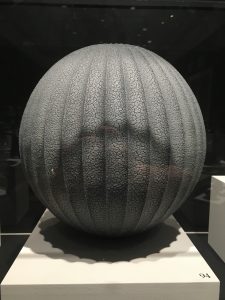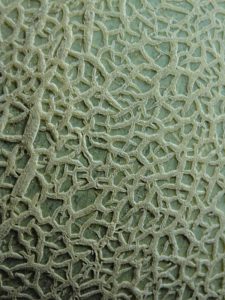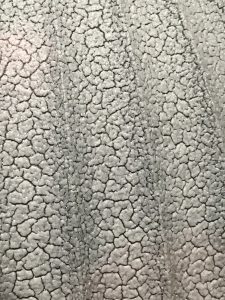Unassuming at first glance, and tucked away towards the far end of the exhibition path, Sakai Hiroshi’s “Ai-Iro Shino” in fact commands center stage. It’s a large sphere, about a foot and a half in width and height, with concentric edges that radiate continuously around its sides. Even as a stationary object, a sense of movement or motion emanates from the ball, in many senses: the edges travel around the sides and reference infinite or perpetual motion, but the fact that the piece is a ball itself also implies rolling or tipping over. But as it stands, the ball has come to rest, and perfectly so.
Yet the true power of the piece derives from its texture. Walking by it for the first time, I glanced over the piece, not noticing anything special. But when I stopped to look at a pot adjacent to the ball, I spotted that texture straight away, and was fascinated.The object guide provided by the Ackland revealed that Sakai is famous for his spin on traditional Shino glaze. Whereas traditional Shino ware is “usually covered in a milky white glaze with some grayish decoration,” Sakai’s addition of blue zaffre–an impure, roasted blue cobalt ore–gives this piece is deep, ambiguous blue-grey color. Sakai’s manipulation of an ancient technique elevates the piece into a contemporary conceptual place–one that is defined by its almost alien color and texture.
The cracks in the Shino glaze look so similar to the earthen cracks of canyons that one might see from an overhead plane; but they also conjure images of the interconnectivity of organic systems, like human arteries or plant veins. This made me start thinking of the object as living, or at least once-living; the texture of the glaze combined with the concentric ridging of the edges reminded me of a melon or cantaloupe (below left). But, of course, there are no blue-grey cantaloupes in the natural world. And as I realized that the Sakai piece had been exhibited among other objects that were neither grey nor black, purple or blue, I started to think of the implications of its color.
A painter friend and I have recently been discussing the concept of indigo. Without rambling or going into too much science-y detail, I’ll just say: the mythology surrounding the color indigo is extensive. As it is a color between colors, many artists and scientists, since ancient Greece, have debated over whether or not the color can truly be parsed as a discrete color itself–or if the human brain and eye are even physically capable of perceiving it. This idea of a Platonic, or “true” indigo, has spawned an almost alchemical craze for centuries, as artists have been in search of pigment sources that are able to create this color-between-colors. Oliver Sacks, the famed neurologist, even thought of heaven or the afterlife as consisting of indigo, of a color that no human eye had ever truly perceived. Under the influence of LSD, amphetamines, and marijuana, he described his hallucination of indigo: “And then, as if thrown by a giant paintbrush, there appeared a huge, trembling, pear-shaped blob of the purest indigo. Luminous, numinous, it filled me with rapture: it was the color of heaven, the color, I thought, that Giotto spent a lifetime trying to get but never achieved—never achieved, perhaps, because the color of heaven is not to be seen on earth. But it existed once, I thought—it was the color of the Paleozoic sea, the color the ocean used to be.”
I think Sakai’s piece–in its liminal status between inanimate stone and organic fruit, between stasis and kinesis, between blue, grey, and purple–occupies that same otherworldly space.
